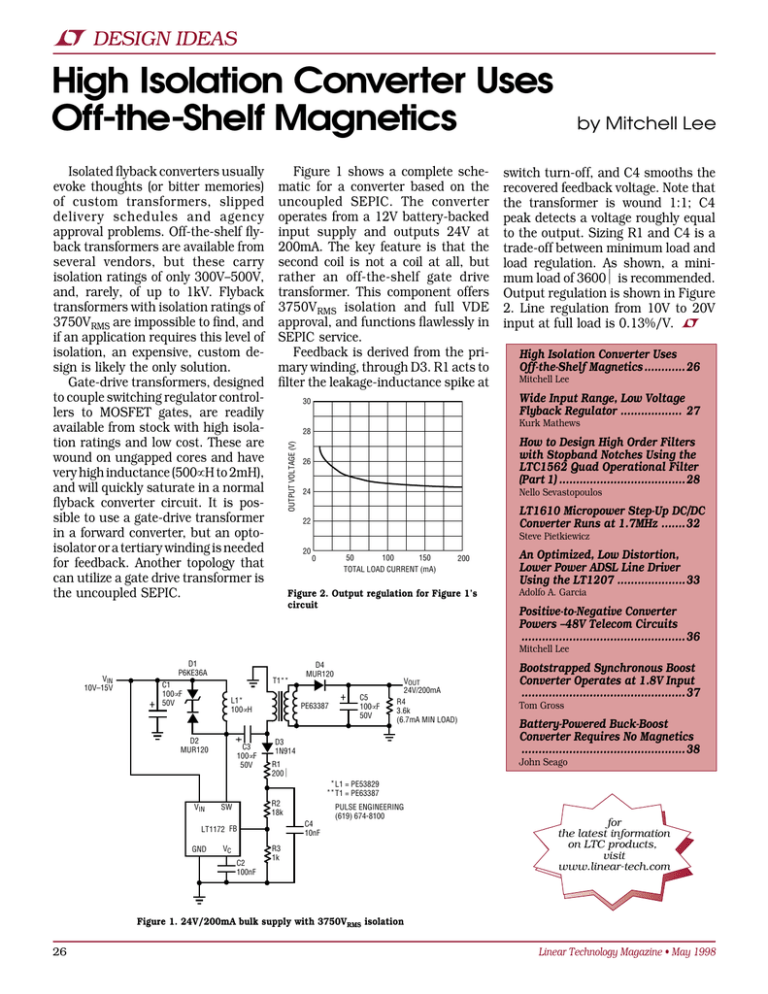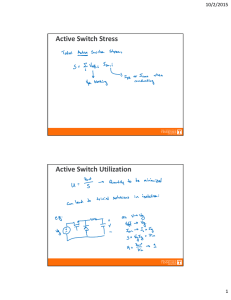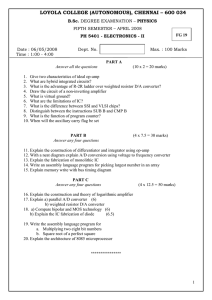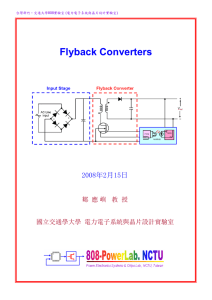May 1998 High Isolation Converter Uses Off-the
advertisement

DESIGN IDEAS High Isolation Converter Uses Off-the-Shelf Magnetics Figure 1 shows a complete schematic for a converter based on the uncoupled SEPIC. The converter operates from a 12V battery-backed input supply and outputs 24V at 200mA. The key feature is that the second coil is not a coil at all, but rather an off-the-shelf gate drive transformer. This component offers 3750VRMS isolation and full VDE approval, and functions flawlessly in SEPIC service. Feedback is derived from the primary winding, through D3. R1 acts to filter the leakage-inductance spike at switch turn-off, and C4 smooths the recovered feedback voltage. Note that the transformer is wound 1:1; C4 peak detects a voltage roughly equal to the output. Sizing R1 and C4 is a trade-off between minimum load and load regulation. As shown, a minimum load of 3600Ω is recommended. Output regulation is shown in Figure 2. Line regulation from 10V to 20V input at full load is 0.13%/V. High Isolation Converter Uses Off-the-Shelf Magnetics ............26 Mitchell Lee Wide Input Range, Low Voltage Flyback Regulator .................. 27 30 Kurk Mathews 28 OUTPUT VOLTAGE (V) Isolated flyback converters usually evoke thoughts (or bitter memories) of custom transformers, slipped delivery schedules and agency approval problems. Off-the-shelf flyback transformers are available from several vendors, but these carry isolation ratings of only 300V–500V, and, rarely, of up to 1kV. Flyback transformers with isolation ratings of 3750VRMS are impossible to find, and if an application requires this level of isolation, an expensive, custom design is likely the only solution. Gate-drive transformers, designed to couple switching regulator controllers to MOSFET gates, are readily available from stock with high isolation ratings and low cost. These are wound on ungapped cores and have very high inductance (500µH to 2mH), and will quickly saturate in a normal flyback converter circuit. It is possible to use a gate-drive transformer in a forward converter, but an optoisolator or a tertiary winding is needed for feedback. Another topology that can utilize a gate drive transformer is the uncoupled SEPIC. by Mitchell Lee 26 How to Design High Order Filters with Stopband Notches Using the LTC1562 Quad Operational Filter (Part 1) .....................................28 24 Nello Sevastopoulos LT1610 Micropower Step-Up DC/DC Converter Runs at 1.7MHz .......32 22 Steve Pietkiewicz 20 50 150 100 TOTAL LOAD CURRENT (mA) 0 200 DI_1068_04. EPS Figure 2. Output regulation for Figure 1’s circuit An Optimized, Low Distortion, Lower Power ADSL Line Driver Using the LT1207 ....................33 Adolfo A. Garcia Positive-to-Negative Converter Powers –48V Telecom Circuits ................................................36 Mitchell Lee D1 P6KE36A + T1** C1 100µF 50V + L1* 100µH + VIN 10V–15V D2 MUR120 C3 100µF 50V D4 MUR120 PE63387 C5 100µF 50V VOUT 24V/200mA R4 3.6k (6.7mA MIN LOAD) D3 1N914 Bootstrapped Synchronous Boost Converter Operates at 1.8V Input ................................................37 Tom Gross Battery-Powered Buck-Boost Converter Requires No Magnetics ................................................38 John Seago R1 200Ω * L1 = PE53829 ** T1 = PE63387 VIN R2 18k SW LT1172 FB GND VC C2 100nF PULSE ENGINEERING (619) 674-8100 C4 10nF R3 1k for the latest information on LTC products, visit www.linear-tech.com Figure 1. 24V/200mA bulk supply with 3750VRMS isolation 26 Linear Technology Magazine • May 1998




